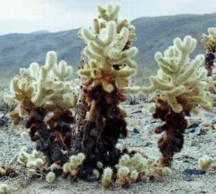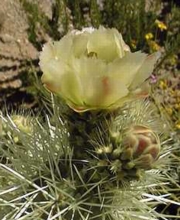

Common Names: Teddybear
Cholla, Silver Cholla, Cholla Guera
Genus: Opuntia
Species: bigelovii

From a distance the jumping cholla, or teddy bear cholla, looks like a fuzzy, soft plant with many short, fuzzy branches looking like teddybear arms, growing from the top. As you get closer you realize that the cuddly looking plant is completely covered with silvery spines. If you are unlucky enough to touch the spines, you will find yourself painfully stuck to a spiny segment that seems to have "jumped" off the plant. Segments will also "jump" when stepped on and attach themselves to your leg.
The segmented joint of the jumping cholla separate easily when brushed up against. These segments can be found littering the ground around the cholla. There they take root and grow, sometimes forming large forests of cuddly looking teddy bear chollas. Although the jumping cholla has flowers and forms fruit, the fruit is usually sterile, and the plant relies on the dropped stems to propagate.
It's dense, 1 inch spines completely hide the stem. The cylindrical segments are light to bluish green. They are about 10 inches (25 cm) long, and 2.5 inches (4 cm) in diameter. The jumping cholla can be 3 to 7 feet (1 to 2 m) tall and has a single trunk with short branches at the top. The spines on young branches are silvery white, and have a detachable, papery sheath. As they age, they become dark chocolate brown to black in color.
The jumping cholla blooms from February to May. The greenish-yellow flowers grow at the end of the stems. They are about 1.5 (2 cm) inches in diameter. The fruit is less than 1 inch (2.5 cm) in diameter, and sometimes has spines growing on it.
The jumping cholla have developed several adaptations to survive in the arid desert environment of its habitat. The thick covering of spines shades the plant from the desert heat. They also prevent animals from eating them. The stems are separated into segments that store water and allow for photosynthesis. They separate easily so that animals, and even a strongwind can disperse them away from the parent cholla.

Jumping chollas grow on the valley floors of the Sonoran Uplands at 100 to 2,000 feet (30 to 600 m), the Mohave Desert, California, and Sonora, Mexico.
2002
Bibliography:
"Teddy bear Cholla Description", http://www.scenicdrive.org/pdteddy.htm
"Adaptations: Teddy Bear Cholla", http://www.webschool.org.uk/science/adaptations2/tsld012.htm
"TEDDY BEAR CHOLLA", http://helios.bto.ed.ac.uk/bto/desertecology/tedimag.htm
"Teddy Bear Cholla (Cylindroputia bigelovii)", http://www.desert-tropicals.com/Plants/Cactaceae/Opuntia_bigelovii.html
Cooper, Andrew. "Teddy Bear Cholla &endash; Cylindropuntia bigelovii", http://www.whitethornhouse.com/cacti/cacti01-07.htm